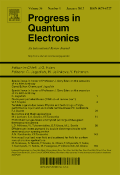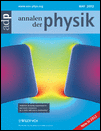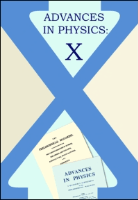
PROGRESS IN QUANTUM ELECTRONICS
Scope & Guideline
Advancing Knowledge in Quantum Technologies
Introduction
Aims and Scopes
- Quantum Optics and Photonics:
The journal emphasizes research on quantum optics, including the behavior of light at the quantum level, photonic systems, and their applications in communication and sensing. - Nanophotonics and Metamaterials:
There is a strong focus on the development and application of nanophotonic devices and metamaterials, which manipulate light on the nanoscale for advanced optical applications. - Quantum Information and Computing:
Research pertaining to quantum information theory, quantum computing, and related error correction methods is a core area of interest, highlighting the intersection of quantum mechanics and computational technologies. - Materials Science in Quantum Technologies:
The journal covers advancements in materials science, especially in the context of quantum materials such as two-dimensional materials, semiconductor lasers, and nanostructures. - Laser Technology and Applications:
Innovations in laser technology, including new laser types and their applications in various fields, are consistently featured, reflecting the journal’s commitment to exploring practical aspects of quantum electronics. - Biophotonics and Biomedical Applications:
The journal also explores the interface of quantum technologies with biology, particularly in biophotonics, emphasizing the use of quantum principles in medical imaging and therapies.
Trending and Emerging
- Quantum Sensing and Imaging:
There is a growing focus on quantum sensing technologies, including quantum radar and LiDAR systems, which leverage quantum mechanics for enhanced measurement capabilities in various fields. - Machine Learning in Photonics:
The application of machine learning techniques to nanophotonic devices and systems is increasingly prominent, showcasing the integration of artificial intelligence with quantum technologies. - Two-Dimensional Materials:
Research on two-dimensional materials like graphene and transition metal dichalcogenides is on the rise, exploring their unique properties for optoelectronic and photonic applications. - Quantum Error Correction:
Emerging work on quantum error correction techniques, particularly using advanced codes like Gottesman-Kitaev-Preskill Codes, indicates a trend towards addressing challenges in quantum computing. - Advanced Laser Systems:
Innovations in high-power and specialized laser systems, including quantum dot lasers and terahertz lasers, are becoming increasingly relevant, reflecting advancements in laser technology.
Declining or Waning
- Traditional Photonic Devices:
There has been a noticeable decrease in publications focusing on conventional photonic devices, such as standard lasers and classic optical components, as the field shifts towards more innovative and hybrid approaches. - Basic Quantum Mechanics:
Basic theoretical explorations of quantum mechanics, while foundational, appear to be waning in favor of applied research that emphasizes technological advancements and practical implementations. - Optical Communication Technologies:
Research specifically dedicated to traditional optical communication technologies has diminished, likely due to the emergence of more advanced concepts such as quantum communication and integrated photonic systems.
Similar Journals

JOURNAL OF RUSSIAN LASER RESEARCH
Illuminating the Future of Laser ScienceThe Journal of Russian Laser Research, published by Springer, stands as a vital resource for researchers and professionals in the fields of atomic and molecular physics, as well as optics and engineering. With its ISSN 1071-2836 and E-ISSN 1573-8760, this journal has been disseminating groundbreaking research since its inception in 1994, with a dedicated focus on the advancement of laser technologies and their applications. While it currently holds a Q4 classification in both Atomic and Molecular Physics and Engineering categories, its commitment to fostering novel insights and innovative methodologies positions it as a promising platform for emerging studies within these disciplines. Although the journal does not offer open access options, it continues to draw attention with a growing citation index. By publishing diverse research articles, reviews, and critical discussions, the Journal of Russian Laser Research not only enriches academic literature but also serves as a stepping stone for students and professionals seeking to deepen their understanding of laser science and its myriad applications.

LASER PHYSICS
Pioneering Research in Atomic and Molecular PhysicsLASER PHYSICS is a premier academic journal published by IOP Publishing Ltd, dedicated to the exploration and advancement of fundamental and applied research in the fields of Atomic and Molecular Physics, Optics, Condensed Matter Physics, Industrial and Manufacturing Engineering, and Instrumentation. Since its inception in 1996, the journal has been a vital resource for researchers and professionals, contributing significantly to the collective understanding of laser technology and its applications. With a consistent Q3 ranking across several sub-disciplines in the 2023 categories, LASER PHYSICS is recognized for its rigorous peer-reviewed articles that push the boundaries of current knowledge. Although primarily subscription-based, the journal aims to disseminate high-quality research to enhance the scientific community's collaboration. As the journal continues to shape the future of laser science until 2024 and beyond, it stands as an essential platform for both emerging and established scholars seeking to publish innovative findings in this dynamic field.

Frontiers of Physics
Igniting Curiosity in the World of PhysicsFrontiers of Physics, published by Higher Education Press, is a premier open-access journal dedicated to fostering innovative research and excellence within the field of physics. With an ISSN of 2095-0462 and an E-ISSN of 2095-0470, this rapidly growing journal has established itself as a valuable platform for disseminating cutting-edge findings, covering a diverse range of topics from theoretical frameworks to experimental advancements. Notably, Frontiers of Physics has achieved an impressive Q1 ranking in the 2023 Scopus Quartiles for Physics and Astronomy, securing a competitive 5th out of 81 positions in its category, reflecting a high impact factor that underscores its importance to the scientific community. Since its inception in 2011 and continuing through 2024, the journal aims to bridge the gap between academia and industry, encouraging collaboration among researchers, professionals, and students alike. Its commitment to open access ensures that high-quality research is readily accessible, thereby promoting knowledge sharing and advancement in the global physics community. Explore the potential of your research in Frontiers of Physics, where the future of physics flourishes.

ANNALEN DER PHYSIK
A Legacy of Excellence in Scientific DiscourseANNALEN DER PHYSIK, a prestigious journal published by WILEY-V C H VERLAG GMBH, stands as a cornerstone of the field of physics and astronomy since its inception in 1799. With an ISSN of 0003-3804 and an E-ISSN of 1521-3889, this journal provides a platform for innovative research and critical discourse across various domains of physics. Annalen der Physik is currently ranked in the Q2 category for general physics and astronomy, occupying rank #76 out of 243 in Scopus, placing it within the 68th percentile. This indicates its significant impact and the quality of research it publishes. Although the journal does not offer Open Access options, its robust historical lineage and ongoing contributions ensure that it continues to be an essential resource for researchers, professionals, and students alike. For those seeking to stay at the forefront of contemporary physics research, ANNALEN DER PHYSIK represents a vital source of knowledge, innovation, and scholarly communication.

SEMICONDUCTORS
Exploring the depths of atomic and molecular physics.SEMICONDUCTORS, published by PLEIADES PUBLISHING INC, is a prominent journal that provides a platform for researchers and professionals in the fields of Atomic and Molecular Physics, Condensed Matter Physics, and Electronic, Optical and Magnetic Materials. With an ISSN of 1063-7826 and an E-ISSN of 1090-6479, the journal has been diligently disseminating knowledge since its inception in 1996 and continues to pave the way for innovative research until 2024. Although currently unclassified in the Open Access model, its influence is underscored by its rankings in Scopus, where it ranks in the 21st-22nd percentile across critical scientific categories. SEMICONDUCTORS serves as an essential resource for cutting-edge research, fostering a greater understanding of semiconductor materials and their applications, thereby assisting the scientific community in pushing the boundaries of technology and innovation.

Advanced Quantum Technologies
Transforming Theoretical Concepts into Practical SolutionsAdvanced Quantum Technologies is a leading journal published by WILEY, specializing in the rapidly evolving fields of quantum mechanics and technology. With an impact factor reflecting its rigorous peer-review process and high-quality research, this journal aims to disseminate the latest advancements across multiple disciplines, including Computational Theory and Mathematics, Condensed Matter Physics, and Electrical and Electronic Engineering. Since its inception in 2018, it has garnered a prominent reputation, as evidenced by its Q1 ranking in several categories for 2023 and its high percentiles in Scopus rankings, showcasing its significant contributions to the academic community. Researchers and professionals alike will find valuable insights within its pages, promoting innovations that bridge theoretical frameworks and practical applications. Although currently not an Open Access journal, Advanced Quantum Technologies continues to strive for excellence, ensuring that its content is accessible and impactful to those who are shaping the future of quantum technologies.

Advanced Photonics Research
Unveiling Breakthroughs in Photonic ScienceAdvanced Photonics Research is a leading open-access journal published by WILEY, dedicated to advancing the field of photonics through rigorous research and comprehensive reviews. With its ISSN 2699-9293, the journal aims to disseminate innovative findings in areas such as photonic materials, devices, systems, and applications. Since transitioning to an Open Access model in 2020, it has significantly increased accessibility for researchers, professionals, and students alike, promoting wider dissemination and collaboration within the global photonics community. The journal's commitment to high-quality, peer-reviewed content ensures it remains an essential resource for those seeking to stay at the forefront of photonics research. Positioned to influence both academia and industry, Advanced Photonics Research is an invaluable platform for sharing cutting-edge discoveries that drive the future of technology.

Science China-Physics Mechanics & Astronomy
Exploring the Frontiers of Mechanics and AstronomyScience China-Physics Mechanics & Astronomy, published by SCIENCE PRESS, stands as a prestigious journal within the Physics and Astronomy domain, particularly recognized for its contributions to the understanding of fundamental and applied physics. With an exhilarating Q1 ranking in the 2023 category and earning a remarkable scopus rank of #21 out of 243, the journal demonstrates its significant impact, being positioned in the 91st percentile of its field. Operating under an Open Access model, it facilitates the broad dissemination of high-quality research, ensuring accessibility for researchers, professionals, and students worldwide. Its scope covers a variety of essential topics in physics and astronomy, promoting a comprehensive understanding of the latest advancements from 2010 through 2024. The journal is a vital resource for anyone aiming to stay at the forefront of research in these dynamic fields, with its prominent address located in Beijing, China, symbolizing its global influence.

Optics Continuum
Pioneering Discoveries in Light and MaterialsOptics Continuum, published by Optica Publishing Group, is a pioneering open access journal dedicated to advancing the field of optics and photonics. Since its inception in 2022, this journal seeks to provide a vital platform for the dissemination of groundbreaking research and innovative developments across several interconnected domains, including electrical and electronic engineering, atomic and molecular physics, and material sciences focused on electronic, optical, and magnetic materials. With impressive rankings in Scopus—placed #384 in Electrical and Electronic Engineering and #109 in Atomic and Molecular Physics—the journal aims to engage a diverse readership comprised of researchers, professionals, and students, promoting collaboration and knowledge exchange. The journal's open access model ensures that cutting-edge research is readily available to all, nurturing an inclusive academic environment. For those interested in staying at the forefront of optics research, Optics Continuum is an essential resource that continuously enriches the global scientific community.

Advances in Physics-X
Driving the Dialogue in Physics and AstronomyAdvances in Physics-X is a premier open-access journal published by Taylor & Francis Ltd, dedicated to advancing the frontiers of knowledge in the field of Physics and Astronomy. Since its inception in 2016, the journal has established itself as a vital platform for researchers and professionals, showcasing innovative research and cutting-edge theories that influence a broad array of sub-disciplines within physics. With an impressive impact factor and ranked in the 94th percentile among its peers, it resides in the Q1 category for Physics and Astronomy (miscellaneous), indicating its significant contributions to the academic community. Located in the United Kingdom, the journal encourages open access to foster wider dissemination and visibility of scholarly works, aligning with contemporary academic trends that prioritize global knowledge sharing. The ongoing commitment to publishing high-quality research ensures that Advances in Physics-X remains an essential resource for students, industry experts, and academics alike, helping to shape the future of physics research through collaboration and innovation.